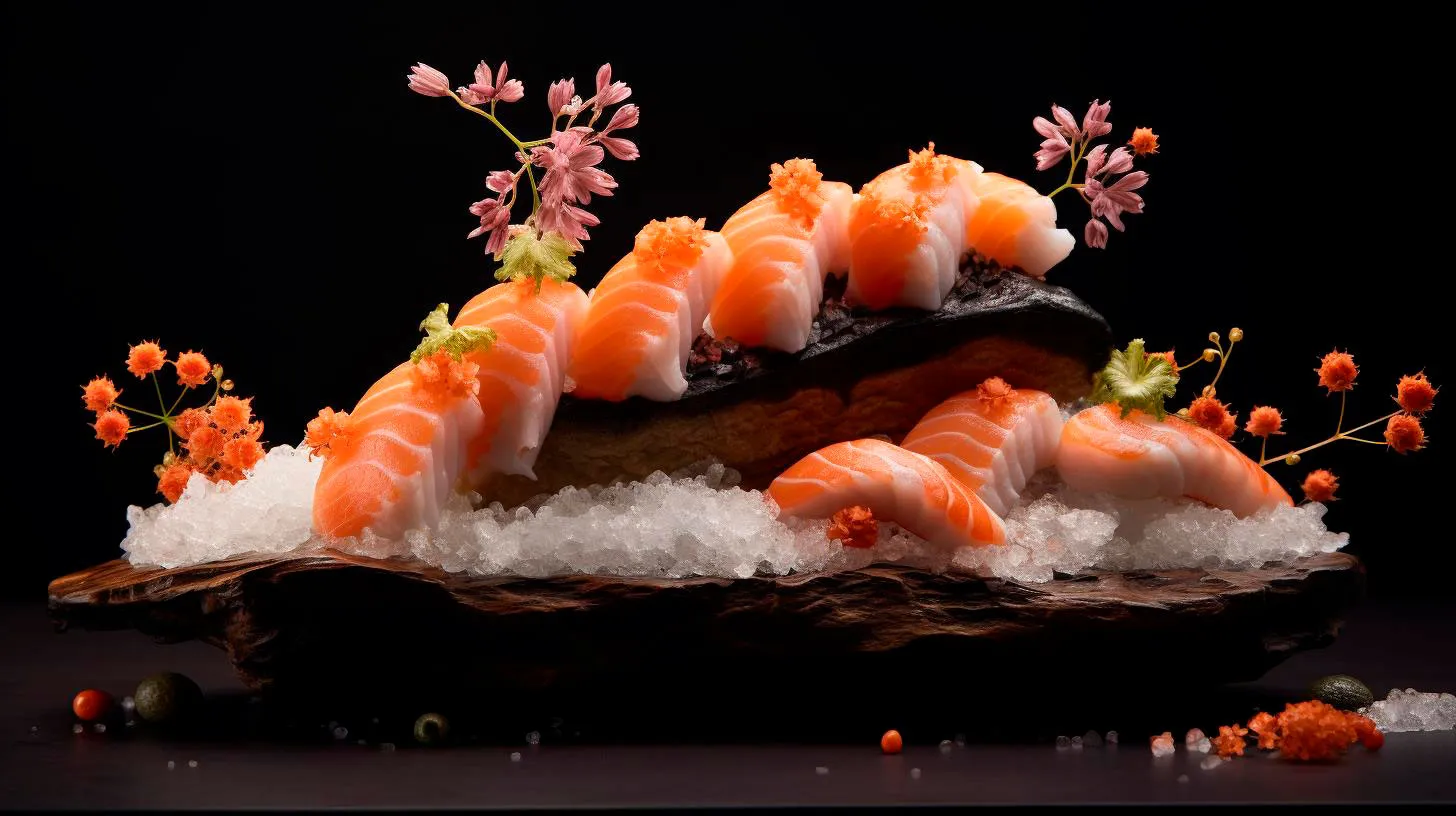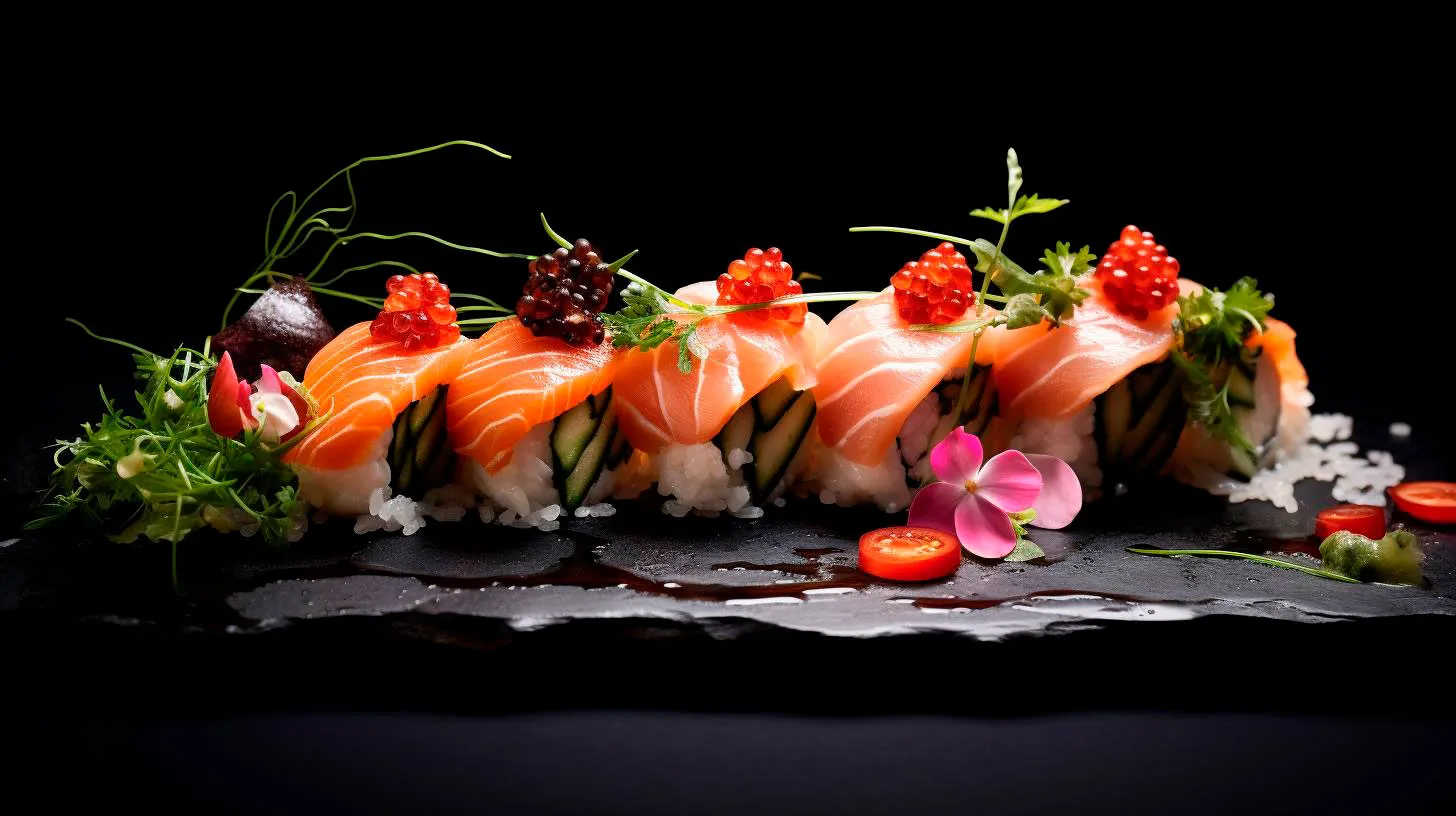From Sashimi to Nigiri: Exploring the Wide Variety of Sushi Types
Join us on a journey as we explore the different types of sushi and discover their unique characteristics.
1. Sashimi: The Art of Raw Fish
Sashimi is one of the most well-known types of sushi. It consists of thin slices of raw fish or seafood, often served with soy sauce and wasabi. Unlike other types of sushi, sashimi does not include rice. Its purity lies in the flavors and textures of the raw ingredients alone. Key characteristics of sashimi include:
- Focus on the highest quality fish or seafood
- Thinly sliced and beautifully presented
- Served with soy sauce, wasabi, and sometimes pickled ginger
- Popular varieties include tuna, salmon, yellowtail, and octopus
The key advantage of sashimi is the ability to fully experience the taste and texture of the fish without any interference from rice or other ingredients. Sashimi is a delicacy that showcases the freshness and quality of the ingredients.
2. Nigiri: Classic Sushi Perfection
Nigiri is likely what comes to mind when you think of sushi. It consists of a small mound of vinegared rice topped with a piece of raw or cooked seafood. Nigiri is typically shaped by hand to create a slight curve, allowing the rice and fish to meld together. Some key features of nigiri include:
- The perfect balance of vinegared rice and fresh fish
- Served with a dab of wasabi between the rice and fish
- Common toppings include tuna, shrimp, salmon, and eel
- Enhanced with soy sauce or a touch of grated ginger
The advantage of nigiri lies in the harmonious combination of flavors and textures. The rice complements the fish, providing a satisfying mouthful in every bite. Nigiri is a classic sushi choice that is enjoyed by sushi aficionados around the world.
3. Maki: A Roll of Artistry
If you prefer your sushi wrapped in seaweed and served in bite-sized pieces, maki is the perfect choice for you. Maki rolls consist of a layer of rice, a variety of fillings, and a sheet of dried seaweed (nori) wrapped around the ingredients. Some key characteristics of maki rolls include:
- Endless possibilities for fillings, including fish, vegetables, and even fruits
- Rolled using a bamboo mat and cut into bite-sized pieces
- Often served with soy sauce and wasabi
- Popular varieties include California roll, spicy tuna roll, and salmon avocado roll
The advantage of maki rolls is their versatility and appealing presentation. They offer a combination of flavors and textures in a visually pleasing format. Maki rolls are widely popular and have become a staple of sushi menus worldwide.
4. Temaki: The Handheld Delight
If you’re looking for a sushi option that you can eat on the go, temaki is the perfect choice. Temaki, also known as a hand roll, is a cone-shaped sushi roll filled with a variety of ingredients. It is typically wrapped in nori seaweed and is meant to be eaten with your hands. Key features of temaki include:
- Customizable fillings that suit your taste preferences
- Easily eaten by hand, making it ideal for a quick and convenient meal
- Common fillings include crab, avocado, cucumber, and spicy tuna
- Enhanced with soy sauce, wasabi, or other condiments
The advantage of temaki lies in its portability and the ability to personalize the fillings according to your liking. It offers a handheld sushi experience that allows you to enjoy sushi anywhere, anytime.
Key Takeaways
- Sashimi showcases the purity and quality of raw fish or seafood.
- Nigiri provides a harmonious balance of vinegared rice and fresh fish.
- Maki rolls offer a variety of fillings and an appealing presentation.
- Temaki is a convenient handheld sushi option that can be enjoyed on the go.
As you can see, the world of sushi is much more than just raw fish and rice. Whether you prefer the simplicity of sashimi, the classic perfection of nigiri, the artistry of maki rolls, or the convenience of temaki, there is a sushi type to suit every palate. So next time you visit a sushi restaurant, don’t hesitate to explore the wide variety of sushi options available to you.
Sushi Party Perfection Tips for Hosting an Unforgettable DIY Sushi Event
1. Plan Your Menu
The key to a successful sushi party lies in planning your menu meticulously. Consider offering a variety of sushi options to cater to different tastes and dietary restrictions. Some popular choices include:
- Classic nigiri sushi
- Tempting sushi rolls
- Refreshing sashimi platters
- Mouthwatering hand rolls
- Vegetarian sushi options
By providing a diverse range of options, you’ll ensure that all your guests can find something they love.
2. Gather Quality Ingredients
Using fresh and high-quality ingredients is vital for creating delicious sushi. Ensure you have access to the following essentials:
- Top-grade sushi rice
- High-quality fish and seafood
- Assorted vegetables and fruits for fillings
- Premium nori seaweed sheets
- Flavorful condiments like soy sauce, wasabi, and pickled ginger
Remember, the better the ingredients, the better your sushi will taste, so don’t compromise on quality.
3. Provide the Right Tools
To ensure your guests have a smooth sushi-making experience, make sure to have the necessary tools:
- Sushi rolling mats
- Sharp knives for slicing
- Bamboo sushi rice paddle
- Chopsticks or sushi forks
- Cutting boards
Having these tools readily available will make it easier for your guests to create beautiful and delicious sushi rolls.
4. Offer a Tutorial
Not everyone may know how to make sushi, so it’s a good idea to provide a brief tutorial before the party begins. Explain the basic techniques, such as how to roll sushi properly and how to slice it evenly.
Consider displaying a step-by-step infographic or even a short video demonstrating the process. This will help guests feel more confident and excited to dive into their sushi-making adventure.
5. Allow Personalization
One of the major advantages of a DIY sushi party is the opportunity for personalization. Encourage your guests to get creative with their rolls by offering an array of fillings and toppings. Some popular options include:
- Fresh fish like salmon, tuna, or yellowtail
- Crunchy vegetables such as cucumber, carrot, and bell peppers
- Avocado slices for a creamy touch
- Toppings like sesame seeds, tempura flakes, and tobiko (fish roe)
By allowing personalization, each guest can craft their own unique sushi masterpiece to indulge in.
6. Decorate and Set the Mood
No party is complete without creating a welcoming atmosphere. Consider decorating your space with Japanese-inspired decor, such as origami paper cranes, cherry blossoms, or lanterns. Play some relaxing traditional Japanese music to set the mood and transport your guests to a sushi bar in Tokyo.
7. Accommodate Dietary Restrictions
It’s essential to be mindful of any dietary restrictions or allergies your guests may have. Label the ingredients clearly and provide alternatives for those with specific needs. Offering vegetarian, gluten-free, or vegan sushi options will ensure that everyone can participate and enjoy the party.
Key Takeaways
- Plan a diverse sushi menu to cater to different preferences.
- Use high-quality ingredients to enhance the taste.
- Ensure you have the necessary tools for convenient sushi-making.
- Provide a tutorial and encourage guests to personalize their rolls.
- Create an inviting ambiance with Japanese-inspired decor and music.
- Accommodate dietary restrictions to ensure everyone can enjoy the experience.
Hosting a DIY sushi party offers a fun, interactive, and delicious experience for your guests. By following these tips, you’ll be well on your way to hosting an unforgettable event that will leave everyone craving more. So gather your friends, roll up your sleeves, and embark on a sushi adventure like no other!
Unlocking the Secrets Mastering the Techniques of Sushi Roll Creation
In this article, I will share the secrets and techniques to help you unlock the art of making sushi rolls like a pro. So, grab your apron and let’s dive in!
Understanding the Basics of Sushi Roll Making
Before we delve into the intricate techniques, it’s essential to have a basic understanding of sushi roll making. The three main types of sushi rolls are Maki, Uramaki, and Temaki. Maki rolls consist of seaweed on the outside, wrapped around the rice and filling. Uramaki rolls are inside-out rolls, where the rice is on the outside and the seaweed wraps the ingredients. Lastly, Temaki rolls are cone-shaped hand rolls.
To create a perfect sushi roll, you need a bamboo sushi mat, known as a makisu, nori (seaweed), sushi rice, and the desired fillings. While sushi rolls can be made with various ingredients, some popular options include fresh fish like tuna or salmon, avocado, cucumber, and crab sticks. The key to achieving a well-balanced and tasty roll lies in the combination and arrangement of these ingredients.
The Secrets to Mastering Sushi Roll Techniques
1. Perfecting the Rice
Rice is the foundation of any sushi roll, so it’s crucial to prepare it correctly. Cook the sushi rice according to the package instructions, and once it’s ready, season it with a mixture of rice vinegar, sugar, and salt. Make sure the rice is slightly warm while seasoning to ensure optimal flavor absorption. Aim for a sticky texture that holds the ingredients together.
2. Proper Nori Placement
When making Maki rolls, position the nori shiny-side down on the bamboo mat. Spread a thin layer of rice evenly over the nori, leaving a small border at the top. Wet your hands to prevent the rice from sticking, and gently press it down to create a smooth surface. Remember to leave some space at the bottom to seal the roll later.
3. Creative Filling Combinations
Experimenting with different filling combinations is where you can showcase your creativity. Whether you prefer traditional options or more unconventional ingredients, the possibilities are endless. Consider combining flavors and textures to create a delightful experience for your palate. Add thin slices of fresh fish, crunchy vegetables, or a touch of spicy mayo to elevate your sushi rolls to the next level.
4. Rolling with Precision
To roll your sushi, start from the end closest to you and lift the bamboo mat over the filling, tucking it in tightly. Apply even pressure with your hands as you roll to ensure a tight and compact sushi roll. Once rolled, use a sharp knife to slice the roll into bite-sized pieces. Remember to wet the knife to prevent the rice from sticking and maintain clean cuts.
The Advantages of Homemade Sushi Rolls
- Endless Customization: Making sushi rolls at home allows you to customize them according to your preferences. You can experiment with different fillings, sauces, and toppings to create unique flavors.
- Economical: Dining at sushi restaurants can be expensive, but making sushi rolls at home is a cost-effective alternative. You can buy ingredients in bulk and create multiple rolls without breaking the bank.
- Health Conscious: By making your own sushi rolls, you have complete control over the quality and freshness of the ingredients. This allows you to make healthier choices and ensure that your sushi is made to your exact standards.
Key Takeaways
Mastering the techniques of sushi roll creation takes practice, patience, and a passion for culinary art. By understanding the basic concepts, perfecting your rice, experimenting with exciting fillings, and rolling with precision, you can unlock the secrets to creating delicious sushi rolls at home. Don’t shy away from trying new flavor combinations and techniques to develop your unique style in sushi roll making. So, why not embark on a delicious sushi journey and impress your family and friends with your newfound skills?
Sushi Love: Exploring the Art of Sushi Making
In this article, we will delve into the world of sushi making and discover the secrets behind this beloved Japanese dish.
The Origins of Sushi
Sushi is believed to have originated in Southeast Asia, where people used fermented rice to preserve fish. Over time, this preservation process evolved, and sushi as we know it today emerged in Japan in the 19th century. Initially, sushi was consumed as street food, but gained popularity across the globe with the introduction of nigiri and maki rolls.
The Basics of Sushi Making
Creating sushi requires meticulous attention to detail and a careful selection of ingredients. Here are the fundamental components of sushi making:
- Sushi Rice: The foundation of sushi is the sticky rice, which is seasoned with rice vinegar, salt, and sugar. This type of rice allows the sushi to hold its shape and adds a subtle tangy flavor.
- Sashimi: Sliced raw fish or seafood is an essential component of sushi. Popular choices include salmon, tuna, shrimp, and squid. It is crucial to select fresh, high-quality ingredients to ensure the best taste.
- Nori: A thin sheet of dried seaweed called nori is used to wrap sushi rolls. It adds a distinct umami flavor and provides structural integrity to the roll.
- Fillings and Toppings: Sushi offers endless possibilities for fillings and toppings. From avocado and cucumber to crab and tempura, you can experiment and create your unique combinations.
The Art of Sushi Making
Sushi making is not just about assembling ingredients. It involves precision knife skills, aesthetic presentation, and a keen sense of balance. Here’s where the artistry comes into play:
- Sushi Knife: A sharp and well-crafted sushi knife is essential for slicing the fish precisely. The knife should be handled with care and maintained regularly to ensure clean cuts.
- Garnishing: Sushi chefs often use various techniques to adorn their creations. Whether it’s shaping the rice into intricate designs, adding vibrant edible flowers, or using bright sauces, garnishing enhances the visual appeal of the sushi.
- Plating: Sushi presentation is an art on its own. Each piece should be placed thoughtfully, demonstrating symmetry and balance. Plates are often adorned with wasabi, ginger, and soy sauce for a complete dining experience.
The Fascination with Sushi Making
Sushi making has gained immense popularity not only for its taste but also for its several advantages:
- Health Benefits: Sushi is considered a healthy food choice due to its low-fat content and high nutritional value. It provides essential omega-3 fatty acids, vitamins, and minerals.
- Creativity and Personalization: Making sushi allows you to explore your creativity and personalize each roll as per your preferences. You can experiment with different fillings, sauces, and presentation styles.
- Culinary Bonding: Sushi making can be a delightful group activity. Gather your friends or family, and embark on a culinary adventure together. It fosters a sense of togetherness and creates lasting memories.
Key Takeaways
Sushi making is an art that combines flavors, textures, and aesthetics. Here are the key takeaways from our exploration of sushi making:
- Create an unforgettable sushi experience by using high-quality, fresh ingredients.
- Develop your knife skills to ensure precise and clean cuts.
- Don’t be afraid to experiment with different flavor combinations and garnishing techniques.
- Enjoy the health benefits of sushi while indulging in a creative and personalized culinary adventure.
Next time you savor a piece of sushi, take a moment to appreciate the artistry behind it. Whether you embark on a sushi making journey or simply enjoy it at a well-renowned sushi restaurant, let the love for this exquisite Japanese cuisine fill your soul.


